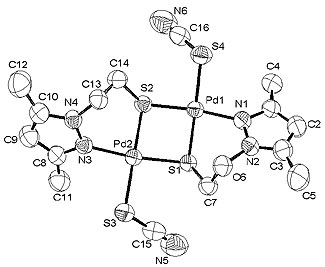New studies on dinuclear platinum complexes

Transition metal complexes attached to some pyrazole-based ligands have the advantage of being versatile, as they can be found in the synthesis of new solid materials or in environmental chemistry, when used in treatments of heavy metal contaminated solutions. A combined team of researchers from Universitat Autònoma de Barcelona and Universitat de Barcelona have synthesized and characterised nickel, palladium and platinum complexes, which contain the μ-med ligand.
The coordination chemistry of transition-metal thiolate, seleniate, and tellurate complexes has been actively pursued in the past several years, motivated primarily by the bonding diversity [i, ii, iii], potential use as precursors to new solid-state materials [iv] and the relevance of such complexes to biomimetic chemistry [v, vi]; they can be used aswell for treatments of heavy metals contamination [v, vi]. These ligands are the hybrid ones containing pirazole groups in its structure, whose applications are being studied nowadays as catalysts in different kinds of reactions, in chemotherapy, electrolytic reductions, magnetic coupling and supramolecular chemistry. Studies about their use in synthesis and stabilisation of nanoparticles have already begun.
Dinucleating ligands containing amine-thiolate units have been reported previously in the literature. This paper present the studies based in the coordination of the ligand NS-donor set, in particular with, N-2-(mercaptoethyl)-3,5-dimethylpyrazole (Hmed) (Figure 1). Recently, we have studied the coordination of the Hmed ligand with metal salts of group 10, obtaining [MCl(μ-med)]2 (M = Ni(II), Pd(II), Pt(II)) [vii, viii]. Here, we extend the study of the coordinative properties of the Hmed ligand to Pd(II). We present the reaction of the [PdCl(μ-med)]2 complex, with NaCN, NaSCN or NaN3 in presence of AgBF4, which yields complexes with formula [Pd(X)(μ-med)]2 (X = CN-, SCN- or N3-).
These complexes have been characterised by elemental analysis, conductivity measurements, IR and NMR spectroscopies. X-ray crystal structures of [Pd(X)(μ-med)]2 (X = SCN- or N3-) are presented (see Figure). These complexes consist of thiolate-bridged dinuclear units. Each Pd(II) is coordinated by a pyrazole nitrogen, two bridging sulfur atoms and one SCN- or N3-.
i E.S. Raper, Coord. Chem. Rev. 165 (1997) 475.
ii J. Arnold, Prog. Inorg. Chem. 43 (1995) 353.
iii N.A. Bell, W. Clegg, S.J. Coles, C.P. Constable, R.W. Harrington, M.B. Hursthouse, M.E. Light, E.S. Raper, C. Sammon, M.R.Walker, Inorg. Chim. Acta 357 (2004) 2091.
iv M.G. Kanatzidis, S. Huang, Coord. Chem. Rev. 130 ( 1994) 509.
v A. Volveda, E. Garcin, C. Piras, A.L. de Lacey, V.M. Fernández, E.C. Hatchikian, M. Frey, J.C. Fontecilla-Camps, J. Am. Chem. Soc. 118 (1996) 12989.
vi M.K. Eidsness, R.A. Scott, B.C. Prickril, D.V. DerVartanian, J. LeGall, I. Moura, J.J.G. Moura, H.D. Peck, Proc. Natl. Acad. Sci. USA 86 (1989) 147.
vii J. García-Antón, J. Pons, X. Solans, M. Font-Bardía, J. Ros, Inorg. Chim. Acta 355 (2003) 87.
viii J. García-Antón, J. Pons, X. Solans, M. Font-Bardía, J. Ros, Inorg. Chim. Acta 357 (2004) 571.
References
"Reactivity of [PdCl(μ-med)]2 with monodentate anionic ligands. Structure of dinuclear complexes [Pd(X)(μ-med)]2 (X = SCN-, N-3). [Hmed = N-2-mercaptoethyl)-3,5-dimethylpyrazole". Antonio de León, Josefina Pons, Jordi García-Antón, Xavier Solans, Mercè Font-Bardía, Josep Ros. Inorganica Chimica Acta, vol. 362 (1528-1534), 2009.


